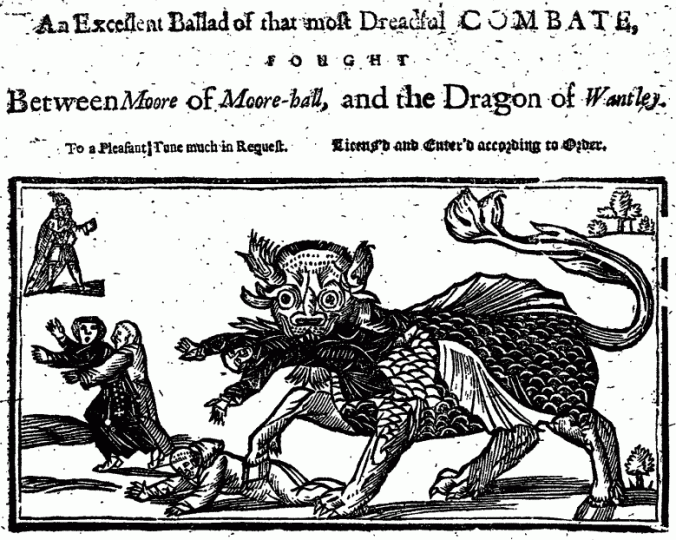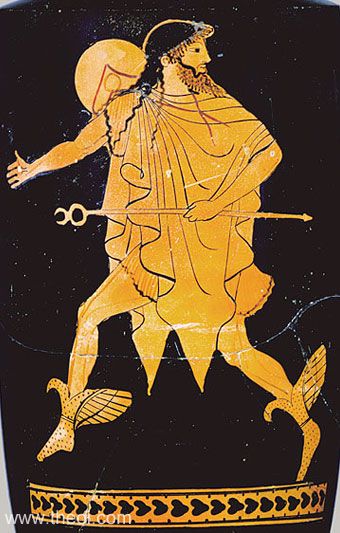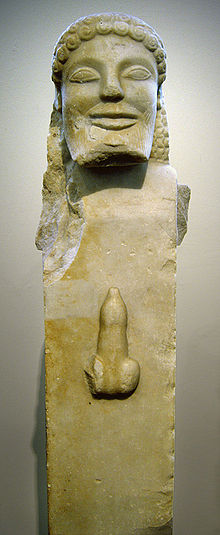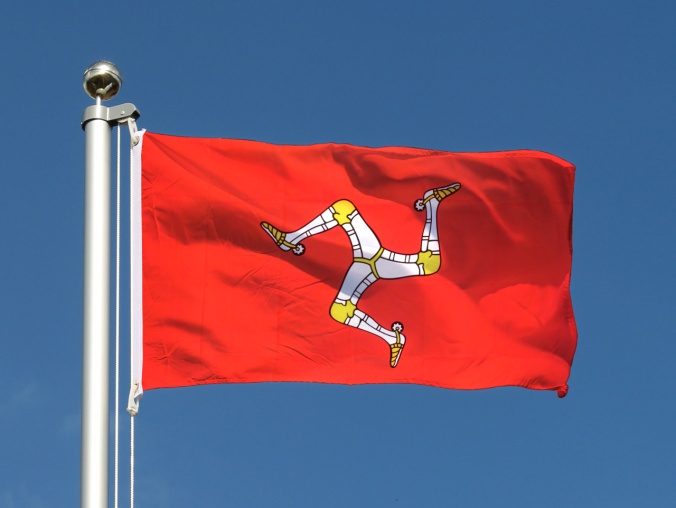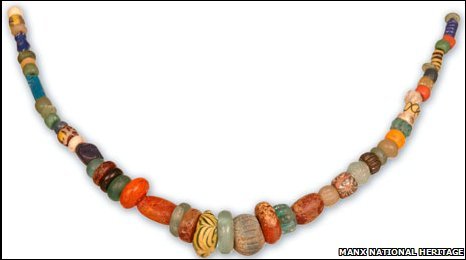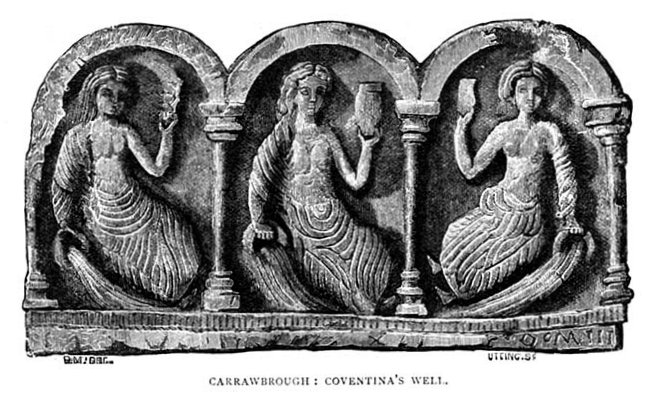The enigmatic fairy-smith ‘Wayland‘ is famed in the legends of the pagan north Europeans, particularly among the speakers of the Scandinavian and Germanic language groups. What is less understood is that his influence is far more widespread – from Ireland in the west, to Russia in the east, and down into the Balkans, whose old regional name almost invokes the god of smithcraft, goldsmithing, weapons and armour – a skill for which these regions (for example , Thracia) and the Eurasian Caucausus were famous for from at least the 5thC BCE. In this essay, I will try and explore and unfold the nature of this ancient pan-European (and Eurasian) conceptual mythological figure who seemed to have a foot in the worlds of both gods and men, and in so-doing unified peoples’ conceptions of their gods and their land.
You can familiarise yourself with the ‘Lay of Volund’ here.
Germanic and Scandinavian Wayland:
The fairy-smith’s name has been encountered in a number of regional spelling-variants, including Wayland or Weyland (English) and Wêland (Old English), Völundr and Velent (Icelandic/Norse Poetic Edda and sagas), Wiolant (Old High German) and Gallant or Galans (France). In the medieval Latin of Geoffrey of Monmouth, it was spelled Guielandus.
His earliest most complete surviving legend is found in the Völundarkviða (‘Poem/Lay of Volund’) of the 13thC Icelandic ‘Poetic Edda’ texts, which were derived from older oral traditions transmitted through the Atlantic archipelago (mainly Britain and Ireland) from Scandinavia and the Baltic provinces – all then part of northern Europe’s most dynamic ocean trade route, connecting via the Volga and the Black Sea to Byzantium. In this telling he is described as a ‘prince of elves’ and ‘one of the elves’ skilled in crafting jewels, weapons and armour with magical qualities.
Wayland is recognisable from the tale of Völundarkviða on the on the images depicted on the 8thC ‘Franks Casket’, currently in the British Museum.
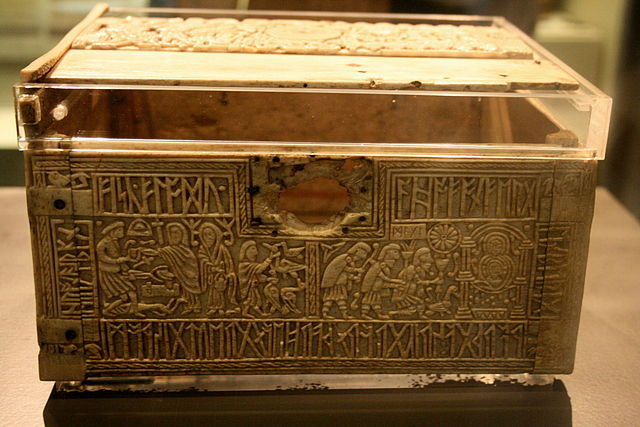
The ‘Franks Casket’. The scene compares the heathen vision of Wayland (on the left) creating life from death with that of the Christian nativity. The two religious ideas were probably considered ‘one and the same’ to the Frankish and Anglo-Saxon peoples of the day.
The early 10thC Anglo-Saxon poem Deor (from the Exeter Book manuscript collection) refers to the details of the Völundarkviða story of Weland, also confirming this later telling was common in earlier Anglo-Saxon England. The fairy-smith is also mentioned (as ‘Weland’) in the 10thC Old English epic poem, Beowulf, as the creator of the hero’s chest armour.
He appears as ‘Velent’ in a side-story to a 13thC Scandinavian retelling of the popular Germanic saga of the life of the Gothic hero-king Theoderic (Dietrich) the Great (Þiðrekssaga/Thidrekssaga). This is itself another version of the story in Völundarkviða albeit different in a number of minor details. For instance, it states that Wayland learned smithcraft under the tutelage of Mimer (possibly the same as Mimir, whose well is to be found among the cthonic roots of the world tree, Yggdrasil) and the dwarves. He presents himself at the court of the King, this time called Nithung, and kills the king’s blacksmith. For this, he is crippled by Nithung and enslaved.
In fact, Wayland is mentioned briefly in all manner of medieval north European texts as a creator of special jewels, weapons and armour. There are also locations throughout northern Europe named after him.
The ‘Celtic’ connection:
Perhaps the most fascinating and generally unrecognised mythological incarnation of Weland is from the ‘Ulster Cycle’ of Irish legends which were written down in Irish and Latin from the 7thC onwards, but emanated from older oral traditions. This is the smith-king Cuillean or ‘Guillean’ – creator of magical weapons and armour for Ulster kings and heroes, and namesake for the famous Irish hero Cuchullain. 19thC Irish mythographer Nicholas O’Kearney had this to say about him in the context of Ireland’s old gods:
“… Aine, or Aighne, as the name is sometimes written, was a being of
great note in the olden times, as may be seen from the evidences
which I shall adduce, and generally supposed to have been possessed
of extraordinary or supernatural powers, having an affinity to the at-
tributes of a Pagan deity. This Aine was the sister of Milucradh of
Sliabh Guillean, better known among the peasantry as the Cailleach
Biorar (i.e. the old woman who frequents the water) of Loch Dag-
ruadh, on that mountain, and daughter of Cuillean, or Guillean, from
whom the mountain is supposed to have derived its name. But
before any further notice is given of Aine, it is necessary to give a
short sketch of Guillean himself, in order to show his connexion with
the ancient mythology of Ireland, and lead to the inference that his
daughter, too, was connected with the Pagan worship of our ancestors.
Cuillean, or Guillean, himself was a very famous being that once re-
sided in the Isle of Man, and of so long-lived or mythic a nature, as
to be found living in all ages of Pagan history ; at all events he is re-
presented to have lived at the time when Conchubar Mac Nessa, after-
wards king of Ulster, was a young man, who possessed little pros-
pects of aggrandisement, except what he might win by his sword.
Conchubar, being of an ambitious and enterprising nature, consulted
the oracle of Clochor, and was informed that he should proceed to the
Isle of Man, and get Cuillean, or Guillean, a noted ceard, or worker
in iron, to make a sword, spear, and shield for him ; and that the
buadha (supernatural power) possessed by them would be instrumental
in gaining for him the sovereignty of Ulster… ” Nicholas O’Kearney, Journal of the Royal Society of Antiquaries of Ireland, Volume 2, 1855 (p.32)
Although described in Irish legends as a blacksmith who creates magical weaponry, the connection between Cuillean and the germanic ‘Weland’ is not immediately apparent until you consider the tendency for the ‘Celtic’ languages of ‘lenition‘ (softening) or ‘fortition‘ (hardening) of initial and terminal consonantal sounds. I have discussed this connection previously here. This essentially means that ‘Cuillean’ was often pronounced ‘whallin’ or ‘wellin’ as occurs in the placenames associated with Cuillean in the Isle of Man, where his smithy was supposed in some Irish stories to have been located. In fact there are many more placenames in Ireland associated with Cuillean, although a bit of digging will probably find him in Scotland, Wales and England (where he is referred to as Wayland). If you employ a lenition of the primary consonant, and a fortition of the terminal consonant of the name ‘Cuillean’ you could phonetically pronounce it ‘Wolund‘. Probatum est!
It is of course possible that the character of Cuillean was introduced to the Irish poetic traditions during the Anglo-Saxon era, but this seems unlikely given that the Irish tales have little in common with the narrative of the 13thC Icelandic version of Völundarkviða, which we have fairly good reason to believe was the same myth known in 10thC England and was probably transmitted to Iceland via the ancient sea-routes between Norway, the Isle of Man and Dublin. Of course, this does not preclude the donation of the name of Weland to the myths of a legendary Irish blacksmith during this period of cultural interaction. Obviously, the most likely native character is Gobán Saor, an artificer-architect credited with building of many fabulous architectural structures, usually ecclesiastic. The word gobban actually means ‘blacksmith’, and the euhemerist Irish christians created a number of saints out of the character, known as ‘St Gobban’ or ‘Gobbanus’. As early christian churches were made of wood and stone rather than iron, the Gobán Saor remains a curious figure chosen to erect such structures…
It has also been suggested that the legendary Tuatha Dé Danaan blacksmith-hospitaller Goibniu is the same character, and he does indeed demonstrate the legendary attributes ascribed in the Germanic language legends to Wayland. The Gauls in the Roman period worshipped a god called Gobbanos as well as a hammer-wielding god known as Sucellus, although these may both be epithets of the same deity. The Romano-Britons appear to have incorporated the worship of Vulcan into native religious cults, and Scots and Hebridean folklore makes references to ‘Bolcan Smith’. Mad king Suibne (‘Sweeney’) of Irish folklore eventually settled in ‘Glenn Bolcain’. The ancient settlement of Govan, now a part of Glasgow’s metropolitan district, appears to be named after him and the official legends of their local saint, Mungo (Kentigern) incorporate material from the Cuillean/Weland legends, as well as aspects of Greco-Roman legends of Hephaistos and Vulcan.
Of interest, Kentigern’s famous hagiography compiled by Jocelyn of Furness also borrows details of the tale of the flying wizard Merlin, also used by his friend and contemporary, Geoffrey of Monmouth, who latinised Wayland’s name as Guielandus. Jocelyn used the flying wizard ‘Melinus’ as St Patrick’s adversary in the Isle of Man, redolent of King Suibne of Glen Bolcain, who also flew through the air. Lenition of ‘m’ to a ‘w’ sound is common in Gaelic (samhain = ‘sa-win’) so it can be seen how easily we go from ‘Melinus’ to ‘Welinus’. That crafty wizard – it would make sense for the name of the island where Geoffrey claimed King Arthur’s sword Caliburn was forged – ‘Insula Avalonis’ – could have been derived from a corrupted form of the Gaelic ‘Hy Guiellean’ (pronounced close to ‘A Wulan’ – ‘Isle of Wayland’).
Just what Cuillean was doing in the Isle of Man was anyone’s guess. Perhaps he was sojourning with Manannan, that other great traveller between the worlds and donator of arms and armour…. The deeper you dig, the more intriguing the link becomes!
The Greco-Roman connection:
Greco-Roman culture had a very important influence upon many indigenous north European legends and traditions. Not only was this culture partially-transmitted and deliberately syncretised into the zones of Roman occupation in north Europe, but continued to be used among the literate latin scholars of the early christian church whose literary understanding of paganism was largely based upon Greek and Roman mythology. Given the persistence of much older written and artistic depictions of these gods from mediterranean Europe, it is easy to assume that the Europeans (late-comers as they were to the idea of writing and iconic imagery) borrowed from the southern traditions, but this is not necessarily the case! Many of the Greek and Roman gods and myths are equally likely to have diffused down from northern Europe during the Bronze Age.
One good example of a striking similarity between the legend of Wayland and that of Hephaistos (know to the Romans as Vulcan, and to the Etruscans as Sethlans or Velchanus) is that (apart from being blacksmiths) they are both imagined as being somehow deformed or disabled. In Weland’s case, he is hamstrung by his captors, and in the case of the Greek god, he is said variously to have been born lame, or is injured when he is thrown down from Olympos by Zeus, when he tries to defend his mother Hera (the motif which appears in the 12thC hagiography of St Kentigern). It is of note that in both cases, the crippling precludes re-admission to the world of the divine.
Both Weland and Hephaistos supply legendary heroes and gods with their weapons, armour and tools. Both are wily and cunning and trick and ensnare their adversaries. Both are exiled from their divine right, only to return in triumph. In some Greek myths, the god is liberated from his earthly exile and returned to heaven by Dionysos who places him astride an ass and leads him back to Olympos.

Attic vase painting ca. 5thC BCE. Crippled Hephaistos is led back to his mother Hera on Olympos by the god Dionysos, riding on an ass. Aficionados of Iron Age Celtic coins will recognise the ‘horse’ motif as significant. The myths of the Dioskoroi and Bellerophon also appear related. Note the similarity of the tongs to the ‘caduceus’ of Hermes…
Unlike Hephaistos however, Weland is more of an action-character and a warrior, but he also strides between the human and the spirit worlds. The Volundr Saga and the various known carvings of the Wayland legend on Anglo-Saxon and Viking age artifacts also focus upon his escape from the world of men either with a magical flying machine, upon a giant bird, or with a valkyrie. The ‘flight’ of Hephaistos, by comparison, is through the liberating agency of Dionysus, a famous loosener of the bonds between the earthly and the divine. Both represent a ‘shamanistic’ type of journey of self-discovery, implicit in the perfection of a craftsman. Freemasons take note!
The other Greek deity who travelled between the worlds and had the legendary attribution of being something of a trickster was of course Hermes, who also shared the affections of Aphrodite (and who didn’t?). Aphrodite (emotional love) herself was almost a counter-image of Athena (virgin intellect), and if Athena is the feminine principle of the uncreated idea, Hephaistos was the active principle of a creator. The complex interplay of their principles can nearly drive you mad!
Etruscan Velchans:
Also known as Sethlans, Velchans was the Etruscan progenitor of Roman Vulcan. Little is known about him, although it is likely he merged with Vulcan at some point, so what can be said of Vulcan might apply originally to Velchans. According to later Roman authors commenting upon the substratum of Etrurian religious culture important at the heart of Republican era Roman religion, he was both a god of fire (Vitruvius 1stC, BC) and lightning (Servius, 4thC CE). The Etruscan haruspices or diviners were keen observers of natural phenomena, and lightning was one of the most important and potent of these.
Bellerophon and the Dioskouroi:
Legendary ancient Greek hero, the mortal but ingenious Bellerephon (rider of Pegasus and slayer of the Chimera) is associated with a legend in which he attempts to fly to Mount Olympos on the winged horse Pegasus. Zeus sends a gadfly to bite Pegasus who unseats its rider who tumbles down into a thorn bush and lives out the rest of his earthly existence blind and crippled until Zeus decides to deify him. It will be noted that the constellation ‘Pegasus’ appears to be a falling horse, given its inverted appearance – yet another hint that many myths are star-myths related to the seasonal cycles. Yet again we see the heroic smith-god motif of a fall from grace, injury, and finally divine elevation
In the 10thC Byzantine stela on the Veroli Casket, he is apparently depicted as one of the twin equestrian heroes – the ‘Dioskoroi’, Castor and Polydeukes:

Veroli Casket – This appears to show Bellerephon as one of the Dioskoroi. Note the cherub holding the ring or crown of divinity over the head of Bellerophon/Polydeukes
Bellerophon and Polydeukes represent the semi-divine gifted human, an assignation also common to Weland. The Dioskoroi were said to be children of the swan-maiden Leda, just as Weland was the wife of a swan-maiden (a valkyrie).
The Dioskouroi (literally ‘youth-gods’) seem to have been connected to the youthful cthonic deities of the Samothracian mysteries and those at Lemnos. These were the Kabeiroi, who share similarities with other Hellenised regional youthful groups of hero-deities, such as the Idaean Dactyls, Kouretes and Corybantes. They all ultimately seem connected to the worship of a Great Mother Goddess. The Idaean Dactyls – like the Kabeiroi – were considered masters of smithcraft.
Although Bellerophon (whose cult originates in Corinth) is never explicitly linked to any of these youthful gods by ancient writers, it is evident that he fits their category of semi-divine culture hero. Such heroes are always (so the tales tell us) in need of a steed, weapons and armour in order to complete their quests, and the character of the smith is the enabler in all of these, and with time becomes conflated with the hero. The smith shoes the horses and forges the weapons.
Where the myths of Bellerophon and Pegasus have a striking similarity to those from the Celtic provinces whose saints’ legends (including those of St Patrick, Satan, St Maughold and St Milburga among others) sometimes have the the motif that their leaping horse creates springs of water when its hooves strike the soil. In ancient Greek myth, the hooves of Pegasus create the Hippocrene Well when they strike the rock of Mount Helikon.
Ericthonios of Athens:
Another character arising from the ancestor/hero-cult aspects of ancient Greek mythology is the Athenian progenitor Ericthonius. He was supposed to have had an autocthonous birth when smith-god Hephaistos spilled his semen upon the earth, during a failed attempt to rape Athena. This infers that Hephaistos had intercourse with Gaia and created the primary ancestor of Athenians. This appears to be why Athena (Minerva to the Romans) – a goddess of the mechanical creative arts – can be thought of as the divine reflex of Hephaistos’ earthly manifestation. Athena’s legendary creation was from the head of Zeus, indicating her (virgin) capacity of representing pure mind and technical creativity. Hephaistos represented the manifest earthly power behind that divine will – the passive spirit operating through active physical activity.
Ericthonios was also associated strongly with horses and the creative arts – he is said to have taught the yoking of horses, the smelting of silver, and to have invented the quadriga chariot, as well as teaching the art of ploughing. This makes him a local variant on the Korybantes/Kouretes/Dactyls traditions. He is represented among the constellations by the ‘charioteer’ constellation, Auriga, which (along with Perseus and Aries) lies west of Pegasus, Pisces, Cetus and Aquarius on the celestial ecliptic path. Other horse-related constellations in this vicinity of the sky include Equuleus and Saggitarius. Capricornus lies between both of these. Taurus is also near. The theme of heroes, monsters, horses and grazing horned animals among these constellations fits the ‘semantic field’ of the semi-divine ancestral hero myths very strongly: every city was built upon the achievements of rustic ancestors who wrought all of their needs from nature…
Weland, Donar and Thor – Baltic and Slavic connections:
(Note: For the most explicit descriptions of Baltic and Slavic gods, the reader might wish to study the works of Mireja Gimbutas and Algirdas Greimas)
The medieval Nordic/Icelandic ‘Eddaic’ legends of Thor (equivalent of the older Germanic god Donar or Thunor – literally ‘thunder’) are an interesting mythological combination of the European ‘lightning-wielding sky god’ archetype and the more typical European legendary heroes such as Perseus, Herakles and Cuchullain. His weapon or tool of choice is the hammer, with which he shatters his enemies and the earth itself – he never (at least in the Icelandic myths) plays the role of the blacksmith, which is interesting, and possibly a late revisioning of Thunor or Donar’s original function as a cthonic agricultural deity, much like Roman Mars.
The hammer is, of course, one of the symbolic indicators of smithcraft, the other being the tongs. Instead of tongs, of course, the medieval Nordic Thor possesses a pair of impervious gauntlets and typically achieves his mythological victories through great strength and devil-may-care bravery rather than outright cunning. Nevertheless, these attributes certainly appear to bring Thor directly into Weland’s semantic field, necessitating an examination of how they relate to the other North European air/fire and cthonic/water gods – the Prussian Occopirmus*/Perkons and Pekols/Pushkayts, the Slavic Perun, Veles and Svarog, Lithuanian Perkunas and Velnias, and the Finnish *Ukko (Perkele) and Ilmarinen.
In the middle ages until its acquisition by the Ottomans in 1453, Constantinople was a magnet of power and wealth that attracted north Europeans to its shores to trade and seek their fortune. Consequently, trade and influence networks extended from the Black Sea upwards into the ‘viking’ territories of the Slavs, Rus, Balts and Scandinavians. Looking at it another way, the ‘Viking Empire’ stretched from Iceland in the west to Byzantium in the East! Many of these peoples remained nominally pagan and only partly christian (or jewish) until a very late period: the Kievan Russ (Varangians) and their cousins the Scandinavians officially converted under their leaders in the 10th and 11th centuries, and the Baltic peoples began to convert during a later more indeterminate period leading up to and following the fall of Constantinople, when the influence of Orthodox christianity moved north and west consequent upon Islam’s accession to its seat of power. As a result, there are a number of contemporary written sources and later folklore records of the actual pagan religions of Lesser Russia, Prussia, Lithuania, Latvia and Estonia which were still being practised until relatively recently.
It is perhaps unsurprising to find that there are many similarities between the Nordic, Baltic and Slavic gods, and these – touching on the aforementioned tentative link between Donar/Thunor/Thor and Weland – can help us untangle the meaning behind the enigmatic legendary blacksmith god of the Europeans.
In the east, Perun and Veles (also called Volos) were two closely-linked gods in the Slavic pantheon, notably that of the Kievan Rus until the 10thC and these survived in the guise of the gods Perkunas and Velnias among the Lithuanians until a much later date. These better-attested Baltic counterparts were known by a number of regional names – as Perkele (Ukko) and Ilmarinen in Finland, as Perkele and Pekkols in Prussia, and also as Perkons (Latvia, Estonia). Perkunas and his variants represented the sky (elemental air and fire), whereas Velnias and his variants represented the earth (elemental earth and water). Their various legends point towards an interplay between the two states: the earth and the heavens, or the mundane and the divine. Reconstruction of the underlying theology of these gods, it must be noted, depends upon collecting together details recorded over a period of time spanning almost 1000 years from sources in various different regions.
Perun/Perkunas is a thunder-god. Like Donar/Thor he is associated with wielding a hammer or axe akin to a thunderbolt. He also (like Thor) has been portrayed as either being accompanied by a goat, riding upon a goat, or riding in a chariot pulled by a goat or goats. Devotees of Donar/Thor wore similar hammer/axe amulets to those of Perun/Perkunas. They obviously have a common cultural root.

Thor’s hammer and cross-pendants were associated with worship of a heroic sky-god in pagan and early-christian Scandinavia.

Slavic ‘axe amulet’ c.10-11thC CE (Kievan Rus peoples)

Contemporary gold casting of ‘Crosh Bollan’ amulet from the Isle of Man (courtesy of Celtic Gold). It is cast from the palatal bone of the Bollan Wrasse fish, which bears a striking similarity to ‘Thor’s Hammer’ and the ‘Slavic Axe’. The Isle of Man was once a medieval viking kingdom and was once a principle stop-over destination on the ancient sea trade-routes from the Baltic and Scandinavia.
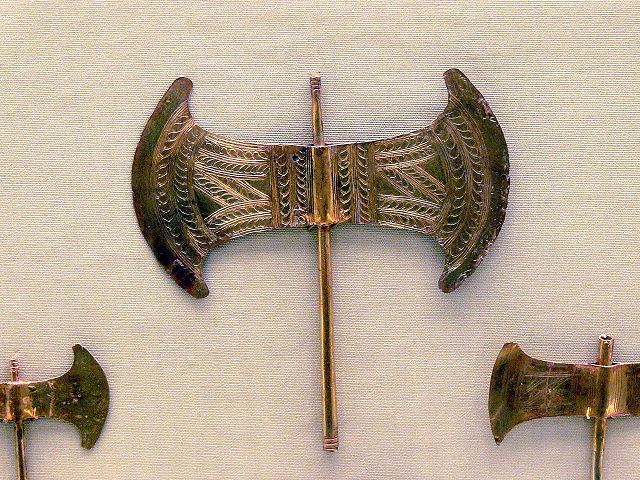
The ancient Minoan Labrys axe. Did it originally come from the Black Sea trade routes with the north?
It should become obvious that Wayland is an intermediary partaker of the qualities of the sky god and the terrestrial-god. In his myth he is confined on earth for a period, but longs for the sky, into which he leaps at the opportunity to escape. Perkunas seemingly represents ‘Sky Wayland’.
Perkunas: why an axe and not a hammer?
Whereas the hammer is archetypally the tool of a blacksmith or stonemason, the axe is the tool of the woodsman and the builder of wooden houses – particularly in the arboreal climes of the Baltic and Russian provinces where wooden houses have predominated, being warmer in harsh winters. Such buildings were ever at the mercy of fire, particularly that occasioned by great tree-splitting bolts of lightning. For these reasons, Perkunas is associated with an axe – he creates by dividing.
Velnias/Velinas as the ‘divine smith’:
Velnias (and his Slavic equivalent), on the other hand, has a terrestrial or subterranean association. It should be fairly clear that similarity with the Scandinavian ‘Velent’ or ‘Volund’ versions of the name of Wayland. In the ancient ‘elemental’ system of thought, Velnias represented Earth and Water – the cthonic and earth-bound forces and the dead. Perkunas represented Air and Fire – they are complimentary to one another. Velnias represents ‘Terrestrial Wayland’ who creates by forging – hammering things together.
The core aspects of the european smith-god legends – be they of Wayland or Hephaistos – represent him as the higher creative fire bound on earth. In Wayland’s tale, he and his two brothers (all elves) fall in love with three valkyries (swan-maidens), and when the swans leave them (the winter migration) Wayland becomes bereft and is captured and enslaved to the human king Nithhad where he is forced to create treasures for him. Weland does as he is bidden but in revenge kills the king’s two sons and makes their bones and teeth into jewels – a gruesome fulfillment of a promise by giving a gift that while of exquisite beauty and value is at once one of utter destruction. Further to this Wayland fulfils a ‘triple-revenge’ by raping and impregnating the king’s daughter, ensuring that the king’s sole inheritor will be of Weland’s divine seed. Upon extracting his revenge, he escapes into the sky on the back of a magical bird (the returning swan?) or in the other version on a flying machine which he himself created, thus re-entering the spiritual realm of air and fire that is the province of the alfar or elves. The allegory is one of winter and the return of vegetation from rot and decay. Weland is the ‘secret smith’ reforging nature within the earth ready for it to re-emerge in springtime. He is a killer AND a giver of life – a perfect archetype of the ‘cthonic’.
Lithuanians in the post-christianised period use the word ‘Velnias’ or ‘Velinas’ to indicate the christian devil, a fact attested in some of the earliest dictionaries translating the Lithuanian language, and it is still the devil’s name in this country. The related word veles (plural) indicated the souls of the dead, who were his ward just as Slavic Volos was described as the god of terrestrial flocks. Velnias rôle in Lithuanian mythology and folklore is as an underworld god – of earth and rivers – who contested with Perkunas, god of fire and sky.
Greimas (in ‘Of Gods and Men’) relates a number of late Lithuanian folklore-tales that he believes link the Devil (‘Velnias’) with an archetypal mythological blacksmith referred to as Kalevelis or Kalvelis – a combination of the Lithuanian word for ‘blacksmith’ and ‘-velis’. Although there are no written references to a god called ‘Kalevelis’, an insertion in a 13thC Slavic manuscript translation of the 6thC Byzantine Malala Chronicle contains an early account of the names of Lithuania’s principle pagan gods. The insertion mentions a god called Teliavelis who forged the sun (Saulė) and threw her into the sky. The 13thC Volyn chronicle also mentions Teliavelis as a god secretly worshipped by a Lithuanian king supposed to have converted to christianity. Neither chronicles name Velnias as a god, although Perkunas is mentioned in the Malala chronicle’s marginalia.
On closer analysis, Teliavelis appears to be the same god as Velnias, lord of the souls of the dead (veles): The prefix ‘Telia-‘ may be related to the latin word for ‘the earth’ – tellus. It might also be related to the Greek word telios (which linguists believe to be a metathesis from an original PIE word kʷelios – remember the Irish ‘Cuillean’?), referring to an end-point, summation, result or termination. The suffix ‘-velis’ appears to relate to the terrestrial god Velnias. Linguistically, this implies an interface where the earthy/watery lower world of Velnias meets the firey/airy upper world of Perkunas. Both prefix and suffix agree with fortive and lenitive metathesis (sound change) seen in Wayland’s various European names.
Linguistic implications of a ‘fallen’ god?
There is something of the tragic and self-sacrificial in the legend of Wayland, a theme echoed by many other mythical heroes and gods connected with his semantic field. Within the corpus of Norse mythology, the other great tragic sacrificial character is that of Baldr, who was accidentally killed by one of his kin who threw a mistletoe dart at him, believing he was impervious to it.
‘Baldr’ is associated with the ‘Phol’ and ‘Wodan’ (a version of the mysterious Eddaic god-triad Odin, Vili and Ve?) in one of the famous 9th//10thC Merseburg Incantations, discovered in a manuscript in the collection of the cathedral chapter of Meresburg in 1841.
Phol and Wodan were riding to the woods,
and the foot of Balder’s foal was sprained
So Sinthgunt, Sunna’s sister, conjured it.
and Frija, Volla’s sister, conjured it.
and Wodan conjured it, as well he could:
Like bone-sprain, so blood-sprain,
so joint-sprain:
Bone to bone, blood to blood,
joints to joints, so may they be mended.
(Translation: Benjamin W. Fortson.)
The relationship between Phol and Baldr is partly ambiguous, but appear to be co-identified in the charm. And who, indeed, is the mysterious ‘Volla’? The B>V>Ph lenition of the initial consonant of his name demonstrates the potential connection to Volund/Weland. He is a mythological figure embodying sacrifice. The name also appears cognate with the Old Norse word for the dead (or ‘fallen’) – val or vol, seen in the name of the otherworld destination, valhalla. In Lithuanian, the spirits of the dead are known by the similar word: veles. Also similar are the Nordic words for mountain, fjall or fjell, and the English words ‘fell’ (hill) and ‘fall’, as in ‘fall down’. This brings us back again into the semantic field of ‘celtic’ spirit and creation myths, where hills were considered to be the start of many things, and the seat of fairies or ancestors. Such hills and mountains were also believed by ancient Scandinavians to be the habitations of dwarves or dark elves whose ability in smithcraft was said to have been unparalleled. Folklore often ascribed the creation of hills and mountains to the dropping or casting of great rocks by giant mythological figures, or the trampling of mythical horses ridden by giants.

A coin of the Gaulish/Belgic Parisii c.1stC BCE. The horse was ubiquitous to coins of the Iron Age ‘celtic’ peoples. Baldr’s horse? The Nikkr? The steed of Hephaistos, even?
The ancient European peoples practised mound-inhumation from the middle stone-age onwards, and there is a famous example of one such neolithic-era mound in England known to this day as ‘Wayland’s Smithy’. The idea that the dead sacrifice themselves so that their souls might be reforged to generate more life seems to have underpinned ancient European belief, and this idea is embodied wholly within the story of Volund or Wayland.
Other linguistic aspects – ‘Will to Power’?:
The suffixes of the names Weland and Volund could also be derived from a common Proto-Indo-European root of the latin verbs meaning ‘to fly‘ and ‘to strive or want‘ – namely volare and volo respectively. The latter gives us the Germanic word ‘will’ (vili in the Scandinavian languages). They are connected by a sense of longing and energy with intent – both ideas encapsulated in the germanic versions of the smith’s legend: In the first case (flying), it is illustrated by his association with swan-maidens (valkyries), and his eventual flight to escape King Niðhad. In the second case, Wayland is very much essentially a man who strives – in his desperate love for his swan-maiden consort, in his work forging vast numbers of items of great beauty and function, in his desire to punish and eventually in his will to be free. He is a transcendental figure who flies his earthly bonds in order to obtain his will of liberation from a terrestrial state. Wayland therefore expresses Friedrich Nietzsche’s idea of ‘Will to Power’, and this is the essence of his potency as a legendary character not just among the Germanic peoples but of all of those indigenous peoples who have weathered the challenges of existing in northern Europe and western Eurasia over thousands of years.









